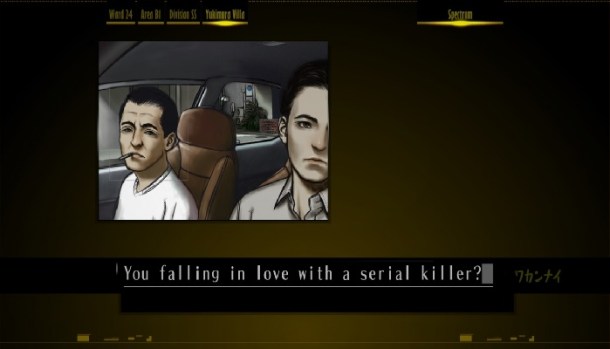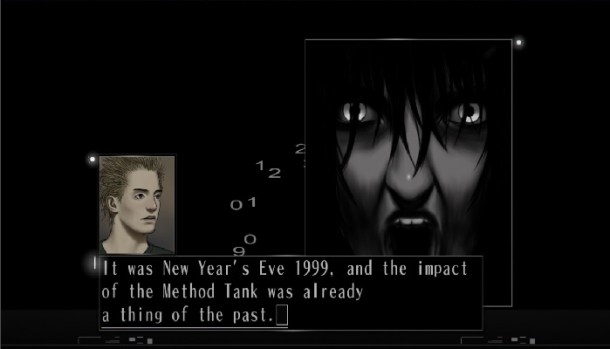 |
|
|---|---|
| Title | The Silver Case HD |
| Developer | Grasshopper Manufacture |
| Publisher | NISA |
| Release Date | April 18th, 2017 |
| Genre | Adventure, Visual Novel |
| Platform | PS4, PC |
| Age Rating | M |
| Official Website | |
Goichi Suda, well-known as Suda51, has became associated with wacky and extremely violent content. His games tend to be off the wall and just insane. Due to their extremity, some players believe there was no substance to the violence depicted. However, Suda has not always developed games such as these. In 1999, Grasshopper Manufacture’s first game for the PSX was released, it was indeed The Silver Case. It would go on to influence his later works, including Killer7 and No More Heroes. Despite its limited budget, the game showcased Suda’s stylized sense of direction at the time.
However, the game never released overseas until recently on October 8th, 2016 with a remaster on the PC published by Active Gaming Media. Then, a port was released for the PS4 with some added content, which is the version covered here. Suda waited a long time to localize it because he wanted to make sure the game had a proper localization. He also wanted to make sure the original atmosphere and setting was kept intact as much as possible. Regardless, there is an option to show the original graphics instead.
Set in a city called the 24 Wards, a string of murders have sprung up, forcing the Heinous Crimes Unit to investigate. The killer, Kamui Uehara, is linked to all of them, despite being killed in “The Silver Case” that took place twenty years ago. Even though deemed unfit to commit a crime, Kamui killed his counselor and escaped from a mental hospital. He also wiped out the Republic’s Special Forces unit tasked to detain him, which the player is the sole survivor of. Working with the Heinous Crimes Unit, you go off to find Kamui, learn who he really is, and in the process discover what the city’s secrets are.
The experience is handled via windows that pop up to depict characters and scenes. All dialogue is handled through text-boxes. However, movement is set in a 3D plane, similar to that of Myst. You’re only allowed to stand at selected points in the area as shown by wireframe triangles. Event points and interactive points are depicted by “suns”. Movement is somewhat clunky though, due to the action wheel. All actions are displayed on a wheel on the bottom-right corner. M is for movement, S for system, I is for implement, and C for contact. This is odd as everything can be selected via button press by hitting L1.
To move, you first have to select movement via the wheel or L1. Yet, contact can be selected by triangle. It would have been better to have everything mapped to a button by default. For example, implement can be square and system can be circle. If this extra step was removed, movement to action would be much smoother.
Contributing as the main element of actual gameplay, there are some puzzles to solve that mainly revolve around numbers and letters. These can be skipped via the magnifying glass icon. However, if done normally, these puzzles can get rather tedious. In case #0, a phrase needs to be typed into a converter to give the actual password then manually type out the given password. Another example is in case #1 where you have the classic “guess the random number” game which randomizes after starting over. Otherwise, you just select the answer given as you search the area or use the appropriate tool. None of these puzzles are really interesting.
It is quite a bit better to judge everything as an experience rather than a traditional game due to the lack of puzzles, mainly around ten in the entire package. Without prior knowledge, the presentation is actually pretty lacking. The window’s field of view does not even encompass 40% of the screen. This means there is a lot of empty space and the window size can make it rather difficult to see certain details. Character portraits do not even change to convey characters’ emotions. 3D scenery and cutscenes look more appropriate for the PS2. Elements like blood or people are only shown through the window when you arrive at the appropriate scene.
Yet, if you were to take account into the experience’s almost non-existent budget, the presentation actually becomes somewhat impressive considering what was accomplished. The atmosphere is actually wonderful, be it chilled or unnerving. The soundtrack is exceptionally good thanks to Masafumi Takada. Not only can it be atmospheric, but it can be rather catchy too. Also, despite the aforementioned lack of elements in the 3D environment, all areas are still exceptionally distinct from each other.
The HD version is also extremely faithful to the original. All portraits, drawings, and 3D imagery closely resemble to their original counterparts. 3D is just spruced from looking like PS1 to PS2, and portraits are no longer fuzzy. Though the HD version did make one super improvement and that is the background. Before, it was just one color. Now there are some actual background elements, be it moving lines, some stylized text or numbers, or just some more color. Plus, on occasion live-action or animated cutscenes will play where all of them still look the way they were in 1999. The field of view is still an issue I find though, being an actual problem from the original version.
Despite the atmosphere, the story is only okay. There are two sides of the experience’s coin. In Transmission, you are a nameless investigator who solves certain mysteries. Then there is Placebo, where you are in the perspective of freelance reporter Tokio Morishima. You unlock his chapters after doing a case as they play off the case you just did. Transmission is written by Suda, while Placebo is written by Masahi Ooka and Sato Kato. Automatically this causes a sharp divide in direction. The silent protagonist does not really solve cases instead more so is directed by other characters. Then you have Tokio who can actually advance the plot by himself. The two sides also feature different character portraits where Transmission Tokio barely resembles Placebo Tokio.
Placebo, despite being more interesting than the actual cases, rarely treads new ground. It might clear up some things but certainly does not do much. The characters I also find are played too straight. The only characters I cared about were Tetsu, Tokio, and somewhat Sumio. This does not mean the characters are badly written however. Character interactions are entertaining in their own right. It is just the characters, if you were to analyze them by themselves, are just not very interesting. With some of the more ridiculous elements in the plot, they sort of take it rather plainly.
Pacing also needs some rather major fine-tuning. Despite the main plot being about Kamui Uehara, cases 2 to most of 4 are about something else entirely. There is not even a vague connection to be made; they are standalone. For something titled “The Silver Case”, it certainly does not relate back to said case all that often. Mind you, these cases can still be absolutely enthralling with interesting set-pieces and history to learn. The plot just focuses on unrelated content then boomerangs back into focus.
Any semblance of an overarching plot is hindered since these cases do not come together into one. In fact, Placebo is a better set-up for a main story. Tokio drives the plot quite well, as he actively searches for information despite being a tool. The characters he interacts with, even if it is only by email, also move everything forward.
Plus, the ending is very underwhelming. It has a rather ridiculous moment that is out of place even for a Suda game. Also, it ends on a cliffhanger leaving much to desire. YAMI expands on this ending but ends on its own cliffhanger. Then there is Whiteout Prologue which leads into Ward 25. Both of them super short so there is not much else to say.
Needless to say, the experience is better taken as some sort of documentation. A document that would detail the worlds and style Suda51 would grow to expand before he made No More Heroes and similar titles. While I enjoyed the ride, it is still difficult to recommend even for Suda fans, be it at full price of thirty or lower.
| Review Score | |
|---|---|
| Overall | |
Review copy provided by the publisher.








